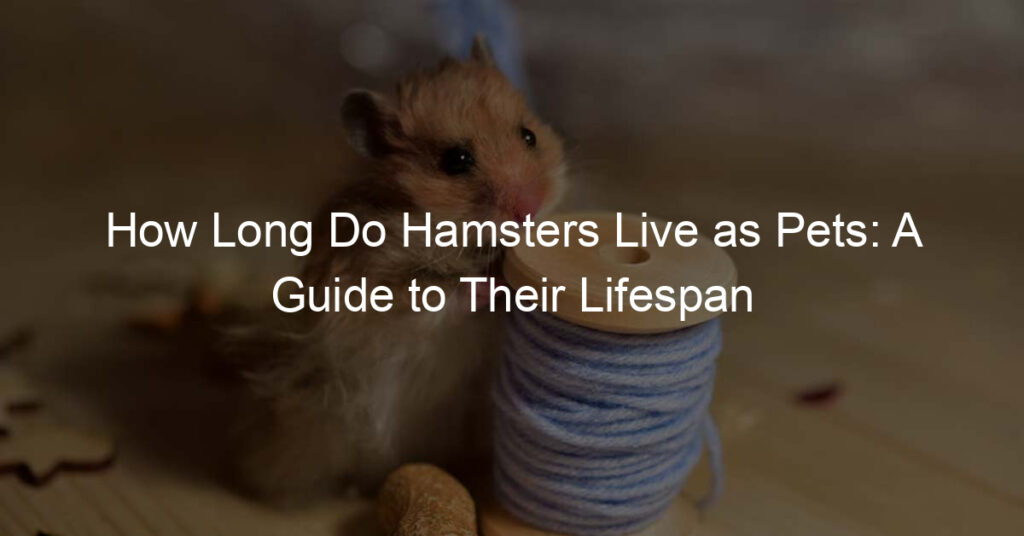Hamsters are popular pets for many reasons, one being their ease of care and their docile nature when handled frequently.
Yet, one aspect of owning a hamster that may concern potential owners is how long do hamsters live as pets.
Understanding the factors affecting a hamster’s lifespan can help potential owners better prepare for the joys and eventual heartaches associated with these fascinating little animals.
Pet hamsters generally have a lifespan of 1.5 to 4 years, with some even living longer. This wide range may be influenced by factors such as genetics, diet, environment, and overall health.
Different breeds of hamsters may also have slightly different lifespans. While wild European hamsters can live up to 8 years, pet dwarf hamsters typically live for 2-3 years.
Providing proper care, a healthy diet, and regular exercise can contribute to a longer, healthier life for your furry companion.
Key Takeaways
- Pet hamsters generally live for 1.5 to 4 years, depending on factors like genetics, diet, environment, and overall health.
- Different breeds of hamsters can have varying lifespans, with wild European hamsters living up to 8 years and pet dwarf hamsters typically living 2-3 years.
- Proper care, a healthy diet, and regular exercise can help extend a hamster’s lifespan and ensure they live a full, happy life.
How Long Do Hamsters Live as Pets
When it comes to understanding the lifespan of hamsters as pets, there are a few factors to consider. On average, hamsters live about 18-36 months, with some variations depending on the breed.
For instance, the Syrian hamster breed is more likely to live longer than dwarf varieties. It’s important to note that any hamster that is a year and a half old is considered elderly.
The lifespan of a hamster generally ranges between 2 to 3 years. These small, adorable pets are low maintenance and are easy to handle, making them suitable for various kinds of households.
They do not require much space, which adds to their popularity as pets.
Genetics and breeding play significant roles in a hamster’s lifespan. Adopting a healthy hamster is crucial to ensuring a longer life for your pet.
It’s essential to be aware that consanguinity and inbreeding can negatively affect a hamster’s life span.
Interestingly, while most pet hamsters tend to live between 1.5 to 4 years, wild hamsters can live longer in some cases. For example, the European hamster can live for up to 8 years.
Nevertheless, they have a shorter average life expectancy than pet hamsters, as their young are often killed by predators.
To better understand and provide adequate care for your pet hamster, it’s vital to be aware of the factors that influence their lifespan.
By making informed choices and providing a healthy environment, you can create the optimal conditions for your pet hamster to live a long and happy life.
Different Breeds of Hamsters
Hamsters are popular pets due to their small size, adorable appearance, and easy maintenance. There are various breeds of hamsters, each having unique characteristics and lifespans.
In this section, we will discuss three common breeds: Syrian Hamsters, Dwarf Hamsters, and Chinese Hamsters.
Syrian Hamsters
Syrian Hamsters, also known as Golden Hamsters or Teddy Bear Hamsters, are the largest and most popular breed of domestic hamsters.
They have a friendly demeanor and are perfect for beginners and families as long as they are housed individually.
Syrian Hamsters have a lifespan of 2 to 3 years, making them a relatively short-term commitment compared to other pets.
Dwarf Hamsters
Dwarf Hamsters are small, sociable, and active pets that come in different sub-species. They are popular choices for responsible children, apartment dwellers, and those looking for a more space-efficient pet.
Dwarf Hamsters have varying lifespans according to their sub-species:
- Dwarf Campbells Russian Hamster: 1.5 to 2.5 years
- Dwarf Winter White Russian Hamster: 1 to 3 years
- Roborovski Hamster: 2 to 3 years
These petite pets tend to be more energetic than Syrian Hamsters and may require additional stimulation and interaction to keep them content.
Chinese Hamsters
Chinese Hamsters are a unique and slender breed with a prehensile tail that allows them to balance similarly to a mouse. These little pets are known for their alert and inquisitive nature, as well as their agility.
Chinese Hamsters are generally friendly, but they can be a bit more skittish than other breeds. They have a lifespan of 2 to 3 years, comparable to Syrian and Dwarf Hamsters.
The different breeds of hamsters offer unique qualities and have varying lifespans. It is essential to consider their specific needs, size, behavior, and longevity when choosing a hamster as a pet.
Proper care and attention will ensure that your furry friend lives a healthy and happy life!
Hamsters: Domestic and Wild
Hamsters are small, furry creatures that make popular pets due to their cute appearance and manageable size.
Their lifespan can vary greatly, with domesticated hamsters usually living shorter lives than their wild counterparts.
Domesticated Hamsters
Pet hamsters typically live for 2 to 3 years. This relatively short lifespan can be attributed to various factors, including their living conditions, diet, and healthcare. Hamster owners should be aware that the care they provide can greatly impact the lifespan of their furry friends.
A clean, comfortable environment with enough space to roam, proper nutrition, and regular veterinary check-ups are essential to ensure their pets live healthily for as long as possible.
Wild Hamsters
In their natural habitat, hamsters can live longer lives than their domestic counterparts. For example, the European hamster (Cricetus cricetus) can live for up to 8 years!
However, wild hamsters face more dangers and often have a shorter average life expectancy than pet hamsters. This is because their survival is threatened by predators, such as owls and foxes, and challenges presented by their environment.
Despite these challenges, wild hamsters can thrive in a variety of habitats, ranging from grasslands and forests to agricultural fields. Their ability to adapt to such diverse environments plays a significant role in their longevity.
Both domestic and wild hamsters have varying lifespans, largely influenced by factors in their respective living conditions. While pet hamsters might typically live for 2 to 3 years, their wild relatives have the potential to live much longer in the right conditions.
Proper Hamster Care
Caring for a pet hamster involves providing a balanced diet, a clean and comfortable habitat, and regular veterinary check-ups.
This section provides guidelines on how to meet your hamster’s needs and ensure they lead a healthy and happy life.
Hamster Diet
A hamster’s diet should consist of a variety of food items to ensure they receive the necessary nutrients.
High-quality commercial hamster food, fresh fruits, vegetables, and small amounts of protein-rich foods should be included in their diet:
- Commercial hamster food: Pellets or seed mixes specifically designed for hamsters provide a balanced diet necessary for their growth and development.
- Fresh fruits and vegetables: In moderation, fruits and vegetables like apples, carrots, and spinach can be offered as treats and supplements to their main diet.
- Protein-rich foods: Hamsters can benefit from small amounts of protein sources like boiled eggs or cooked lean meat once or twice a week.
Always provide fresh water in a water bottle or bowl for your hamster and monitor their food intake to prevent overeating or hoarding.
Hamster Habitation
Creating a clean and comfortable living environment is crucial in ensuring your hamster’s health and happiness.
Consider the following factors when setting up and maintaining their habitat:
- Cage: Opt for a cage with ample space and good ventilation. The minimum recommended size for a Syrian hamster is 450 square inches of floor space, while other smaller species require at least 360 square inches.
- Bedding: Use unscented, non-toxic bedding materials like paper or aspen shavings to cover the bottom of the cage. Avoid cedar or pine bedding, as they can cause respiratory issues.
- Environment: Place the cage in a quiet and temperature-controlled area, away from direct sunlight and drafts. Hamsters are sensitive to temperature changes and loud noises.
- Cleanliness: Clean and disinfect the cage regularly to maintain a healthy living space. Remove soiled bedding daily and replace the entire bedding at least once a week.
Include toys, exercise wheels, and hiding spots in the cage to enrich your hamster’s environment and help them stay active and entertained.
Regular Check-ups
Routine visits to the veterinarian are essential for maintaining your hamster’s health. Regular check-ups can help detect potential health problems early and ensure your pet receives appropriate treatment if needed.
In addition to check-ups, consult your vet for emergency care if you notice signs of illness or injury in your hamster.
Impact of Hamster Exercise
Hamsters are active little creatures that require an adequate amount of exercise to maintain a healthy lifestyle. Exercise plays a critical role in their well-being, as it helps them maintain a healthy weight and prevents obesity.
A proper balance between exercise and diet is essential for their overall health.
Incorporating a hamster wheel or an exercise ball into their habitat provides an excellent opportunity for exercise. These allow hamsters to run and explore their environment, which keeps them fit and mentally stimulated.
It’s important to choose the right size of the wheel for the species of hamster, as it ensures their comfort and well-being during exercise.
Aside from exercise equipment, setting up a playpen or a closed-off area for the hamster to roam around can offer additional exercise opportunities.
Adding tubes or small obstacle courses can further stimulate and engage the hamster during playtime, which is highly beneficial for their mental health.
When considering a hamster’s diet, it’s important to balance exercise with proper nutrition. A well-rounded diet should consist of approximately 75% fortified pellets, 20% vegetables, greens, and fruits, and 5% treats.
Providing hay in the hamster’s habitat can also help with nesting and foraging. This encourages the hamster to be active in searching for food, thus giving it more opportunities for exercise.
Incorporating daily exercise and a well-balanced diet into a hamster’s life significantly contributes to their physical and mental health. A healthy hamster is likely to have a longer and more enjoyable life as a cherished pet.
Signs of Aging in Hamsters
As hamsters grow older, they exhibit certain signs of aging that make it evident they are entering their senior years. It’s essential to recognize these signs in order to provide the appropriate care and adjustments to their living environment.
One of the most noticeable signs of aging in hamsters is a decrease in activity levels. Senior hamsters may prefer to sleep more and engage less in activities like running on their wheel or playing with toys.
This decrease in energy can be attributed to the natural aging process, as their bodies become less agile and efficient.
Another sign of aging in hamsters is a change in their fur. Older hamsters might experience hair loss or thinning, and their fur may appear more unkempt than usual.
This can be a result of decreased grooming habits or a sign of underlying health issues, so it’s important to pay attention to these changes.
Additionally, aging hamsters may experience difficulty moving around their cage or climbing their usual structures. This could be due to joint pain or general weakness associated with aging.
Providing a more accessible living environment with ramps and easy-to-climb structures can make their daily activities less challenging.
Furthermore, senior hamsters might show signs of weight loss or gain. As their body functions begin to slow down, their metabolism might change, affecting their weight.
Monitoring a hamster’s weight regularly can help identify any fluctuations that may require adjustments to their diet or additional vet checkups.
Lastly, older hamsters might display changes in their behavior, such as becoming more irritable or less sociable. This can be a result of discomfort from age-related ailments like arthritis or teeth issues.
It’s crucial to show patience when handling senior hamsters and consult a veterinarian if you notice behavioral changes.
Recognizing the signs of aging in hamsters can help pet owners provide better care for their furry companions, ensuring a comfortable and happy senior life.
Common Hamster Health Issues
Weight Loss
Weight loss in hamsters can be caused by illnesses, stress, or poor nutrition. It is essential to monitor your hamster’s weight regularly to ensure they are maintaining a healthy weight.
Providing a balanced diet made up of 75% fortified pellets, 20% veggies, greens, and fruits, as well as 5% treats, can help prevent weight loss in your pet.
If your hamster’s weight continues to drop, consider consulting a veterinarian for advice and proper care.
Dental Issues
Hamsters can experience dental problems, such as overgrown or misaligned teeth. It’s crucial to regularly inspect your hamster’s teeth to catch any potential issues early on.
Providing harder foods, such as hay and chew toys, can help keep your hamster’s teeth trimmed and healthy. In some cases, softer foods may be necessary for hamsters with severe dental issues.
If you notice signs of dental problems, seek veterinary care to prevent further complications.
Wet Tail
Wet tail is a serious and potentially fatal condition in hamsters, characterized by severe diarrhea.
It is often caused by stress or bacterial infections and requires immediate attention to ensure your hamster’s health. Symptoms of a wet tail include lethargy, a foul-smelling and wet hind area, and loss of appetite.
If your hamster exhibits any of these signs, consult with a veterinarian as soon as possible to determine the best course of treatment.
The Joy of Pet Hamsters
Hamsters are beloved pets known for their small size, adorable appearance, and friendly nature. These furry little creatures make excellent companions and are well-suited to be family pets, bringing joy to households with their playful antics.
In addition to their endearing qualities, hamsters are relatively low-maintenance pets. They require only a simple and clean habitat, a diet mainly consisting of fortified pellets, occasional veggies, and fruits, and a few fun accessories for exercise and entertainment.
This makes them an ideal choice for busy families or individuals seeking a pet that is easy to care for.
One of the many charms of owning a hamster as a pet is their unique personalities. Each hamster has its quirks and preferences, making them an engaging and captivating pal.
Whether they prefer running in their wheel at top speed, hoarding snacks in their cheek pouches, or snuggling up for a nap in their cozy den, observing a hamster’s daily activities can be a source of endless delight and fascination.
Nonetheless, it’s essential for potential hamster owners to keep in mind that their lifespan is relatively short, usually averaging two to three years.
While this may seem like a brief time, hamsters can create lasting memories and bonds with their human companions as they navigate their world with curiosity and enthusiasm.
Owning a hamster can be a rewarding and delightful experience. These small, friendly, and low-maintenance pets can brighten any household and make wonderful family companions, providing joy and amusement to those who care for them.
Conclusion
Hamsters are delightful pets known for their adorable appearance and relatively low maintenance requirements. Generally, they have a lifespan of 2 to 3 years, with some even reaching up to 4 years.
It’s crucial to remember that distinct hamster breeds have varying lifespans, and factors such as environment, diet, and level of care can significantly impact their longevity.
A well-balanced diet contributes to a hamster’s overall health, thus extending their lifespan. Providing ample space and a clean habitat can also have a positive impact on their well-being.
Regular veterinary check-ups can help detect any potential issues early, allowing for prompt intervention to maintain a healthy, happy hamster.
In conclusion, while hamsters may not have the longest lifespans compared to other household pets, they certainly bring joy and companionship to their owners.
By ensuring proper care and attention, you can help your pet hamster live to its fullest potential. And remember, always treat your furry friends with kindness and affection; they deserve it.
Frequently Asked Questions
What is the average lifespan of a pet hamster?
Pet hamsters typically live for an average of 2 to 3 years, although some can live longer with proper care and attention.
Which hamster breeds have the longest lifespans?
Different breeds of hamsters have different lifespans. Generally, Syrian hamsters tend to live longer than dwarf varieties.
Does a hamster’s living environment affect its lifespan?
Yes, a hamster’s living environment can significantly affect its lifespan. A clean, stress-free environment, coupled with a balanced diet and mental stimulation, can contribute to a longer and healthier life for a hamster.
What factors contribute to a longer life for a hamster?
Several factors contribute to a longer life for a hamster, including its breed, living environment, diet, exercise, and the level of care provided. A well-cared-for hamster is more likely to enjoy a longer, healthier life.
How can I maximize my hamster’s lifespan?
To maximize your hamster’s lifespan, ensure that its cage is clean, spacious, and well-ventilated. Provide a balanced diet, fresh water daily, and ample opportunities for exercise and mental stimulation.
Regular check-ups with a veterinarian can also help to catch and address any health issues early on.
Do different hamster breeds have varying lifespans?
Yes, different hamster breeds have varying lifespans. While the average lifespan of a pet hamster is 2 to 3 years, some breeds, such as the Syrian hamster, tend to live longer than dwarf varieties.
It’s essential to research the specific breed of hamster you’re interested in to better understand its average lifespan.








